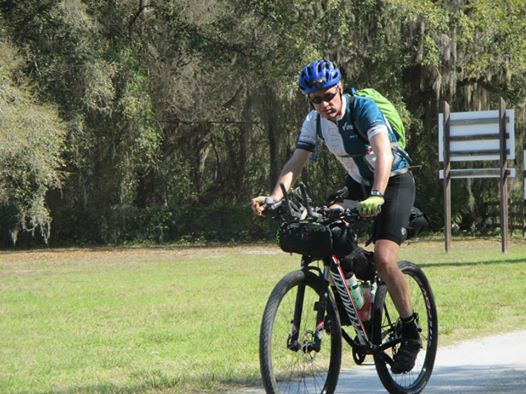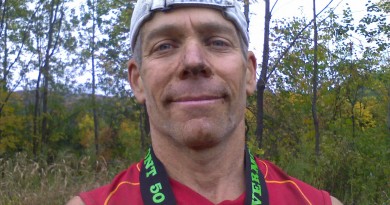Reader Athlete: Jeff Mullen
Age: 54
Residence: Richmond
Family: Wife, Leslie; cat, Tui
Occupation: Information Technology contract work
Primary sport: Bikepacking
Jeff Mullen has always liked adventure sports so when he learned about bikepacking races covering long distances he was immediately intrigued. In 2013 he finished the grueling Tour Divide, which travels the length of the Continental Divide and enjoyed it so much he intends to do it again in 2015.
VS: Please explain bikepacking?
JM: Bikepacking is backpacking with a bike. I’ve always been into racing and adventure sports. I started out as a runner and I’ve done cross-country ski races, but there’s a part of me that didn’t want to train, so this was appealing. I’ve been across the country a few times on my bike and I’ve toured New Zealand, Ireland and Canada. I like being out on my own. I’ve never cared for group rides.
VS: Last year you completed the Tour Divide. Tell us about that.
JM: I first heard about the Tour Divide five to ten years ago and I knew I wanted to do it. Last year was a good time to make it happen because I had the summer off. I did my first bikepacking race the previous fall in Virginia. It was 400 miles and I absolutely loved it. It’s a big adventure with competition. I can’t get enough of it now.
Bikepacking racing is self-sufficient with rules against drafting or support from others. You are supposed to be on your own and you can’t meet up with anyone. You’re not even supposed to share food or help each other out if your bike breaks down.
The Tour Divide is advertised as 2,745 miles, but last year it was 2,850 because of some detours due to forest fires. It goes from Banff, Alberta to Antelope Wells, New Mexico and it climbs almost 200,000 feet on mostly dirt roads and trails. It took me 23 ½ days to finish and I averaged 120 miles a day. There were 143 people at the start; 60 dropped out and I finished 48th — in the middle of the pack, which is what I was hoping for.
VS: What did you carry with you?
JM: My bike was probably 25 pounds and I had another 15-20 pounds of gear. I carried a small tent, but some riders only carried a bivy sack. I had a small sleeping bag, rain gear and extra layers, a couple of tubes, bike repair tools and some extra food and water. You try to go as light and aerodynamic as possible. The more you carry on your seat, the more discomfort you experience and I had some amazing saddle sores.
VS: Did you have any other health issues?
JM: I had road shock through my wrists and for a while I couldn’t use my left hand. I also had excruciating knee pains that would wake me at night. I lost 15-20 pounds and I’m pretty skinny to begin with, so I was down to skin and bones.
VS: You didn’t mention carrying a cook stove. What and how did you eat?
JM: I don’t think anyone carried a cook stove. I stocked up at gas stations and ate convenience store food; a lot of energy bars and junk food. I camped for 16 of the nights, but on the remaining seven I either shared a hotel room or stayed at someone’s house. I tried to keep the expenses down because of the fund-raising I was doing.
VS: Tell us about that.
JM: I had colon cancer in 2008 and this ride came around the five-year anniversary where I’m considered healthy and the risk of relapse is a lot less. I wanted to raise money for the Vermont Cancer Center as a thank you to them. I set up a Facebook page and I raised $7,500. The folks at VCC were great to work with and I got a lot of great support from family, friends and others.
VS: Will you go back?
JM: I would like to, but I can’t this year because I’m starting a new job. I’ve considered doing the Tour Divide Yo-Yo which is going south to north and then north to south, but that’s a pipe dream. I definitely want to go back and I’m hoping to do so in 2015. This spring I did the Huracan 300, which is a 325-mile loop in Florida with 100 miles of single track and some swamp and river crossings. I finished seventh out of 35. I don’t ride a bike during the winter so that showed that skiing is good cross training for biking.
VS: You said there are rules against helping one another. Were you lonely?
JM: You are alone a fair bit, or at least I was. Some folks stay together, but it’s against the spirit of the race. The founders stress that it’s supposed to be an individual time trial, but you do hook up with people in the evening or at lunch. I didn’t mind riding alone.
VS: How do you find time to train?
JM: There really isn’t any specific training and honestly I was never really good at training; I like doing. I just go riding on the back roads around Richmond and Huntington. I did a three-day training ride last spring before the Tour Divide. I carried some weights and camped out a couple of nights.
VS: What other sports do you do?
JM: I like cross-country skiing and I used to do a lot of ski marathons. This year I finally got the gold in the Canadian Ski Marathon. (Editor’s note: the gold level requires participants to ski 160 km in two days while carrying a backpack with their food, sleeping bag and camping equipment). I got the bronze in the late 1990s and thought I’d never go back, but in 2012 my wife and I decided to celebrate my five-year anniversary by skiing it together. I got the silver and she got the bronze. I decided to go back for the gold in 2013, but I hadn’t trained and conditions were slow. After a really cold night of camping I knew I wouldn’t make the cut-off. This year conditions were perfect and I did a little bit of training so I went back and got the gold.


